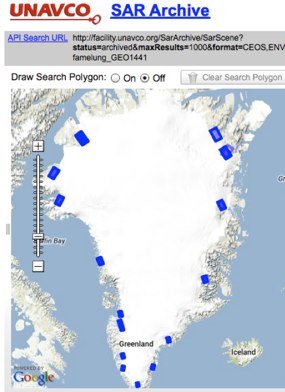Melting Vatnajökull ice cap
 Icelands Vatnajökull ice cap is rapidly melting. The ice loss at the margin is almost 1 meter per year. The Earth’s crust is rebounding in response to the surface load change, a process known as Glacial Isostatic Adjustment (GIA). Wenliang (Kenny) Zhao has used InSAR to measure the ground deformation caused by the load change. We have developped a method to infer the ice load change (the ice mass loss) from the relative InSAR data. See our GCubed_paper.
Icelands Vatnajökull ice cap is rapidly melting. The ice loss at the margin is almost 1 meter per year. The Earth’s crust is rebounding in response to the surface load change, a process known as Glacial Isostatic Adjustment (GIA). Wenliang (Kenny) Zhao has used InSAR to measure the ground deformation caused by the load change. We have developped a method to infer the ice load change (the ice mass loss) from the relative InSAR data. See our GCubed_paper.
Greenland’s Ice Loss
 We have started the acquisition of SAR data with DLR’s TerraSAR-X satellite for about 20 locations along Greenland’s ice sheet margin in summer 2013. From these data we hope to put new constraints on how rapidly the ice sheet is melting and how melting rate varies along the ice margin.
We have started the acquisition of SAR data with DLR’s TerraSAR-X satellite for about 20 locations along Greenland’s ice sheet margin in summer 2013. From these data we hope to put new constraints on how rapidly the ice sheet is melting and how melting rate varies along the ice margin.



 Icelands Vatnajökull ice cap is rapidly melting. The ice loss at the margin is almost 1 meter per year. The Earth’s crust is rebounding in response to the surface load change, a process known as Glacial Isostatic Adjustment (GIA). Wenliang (Kenny) Zhao has used InSAR to measure the ground deformation caused by the load change. We have developped a method to infer the ice load change (the ice mass loss) from the relative InSAR data. See our GCubed_paper.
Icelands Vatnajökull ice cap is rapidly melting. The ice loss at the margin is almost 1 meter per year. The Earth’s crust is rebounding in response to the surface load change, a process known as Glacial Isostatic Adjustment (GIA). Wenliang (Kenny) Zhao has used InSAR to measure the ground deformation caused by the load change. We have developped a method to infer the ice load change (the ice mass loss) from the relative InSAR data. See our GCubed_paper. We have started the acquisition of SAR data with DLR’s TerraSAR-X satellite for about 20 locations along Greenland’s ice sheet margin in summer 2013. From these data we hope to put new constraints on how rapidly the ice sheet is melting and how melting rate varies along the ice margin.
We have started the acquisition of SAR data with DLR’s TerraSAR-X satellite for about 20 locations along Greenland’s ice sheet margin in summer 2013. From these data we hope to put new constraints on how rapidly the ice sheet is melting and how melting rate varies along the ice margin.